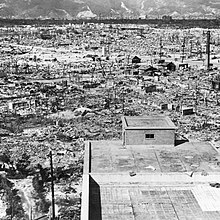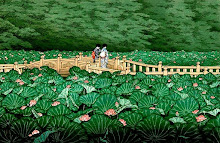August 6, 1945, Hiroshima & the Atomic Bomb
During World War II, the Second Army and Chugoku Regional Army were headquartered in Hiroshima, and the Army Marine Headquarters was located at Ujina port. The city also had large depots of military supplies, and was a key center for shipping.
The bombing of Tokyo and other cities in Japan during World War II caused widespread destruction and hundreds of thousands of deaths, nearly all civilians, predominantly women and children. For example, Toyama, an urban area of 128,000, was nearly fully destroyed, and incendiary attacks on Tokyo are believed to have claimed 90,000 lives. There were no such air raids in Hiroshima. However, the threat was certainly there and to protect against potential firebombings in Hiroshima, students (between 11–14 years) were mobilized to demolish houses and create firebreaks.
On Monday, August 6, 1945, at 8:15 AM, the Atomic Bomb "Little Boy" was dropped on Hiroshima by an American B-29 bomber, the Enola Gay, directly killing an estimated 80,000 people. By the end of the year, injury and radiation brought total casualties to 90,000–140,000. Approximately 69% of the city's buildings were completely destroyed, and about 7% severely damaged.
Research about the effects of the attack was restricted during the occupation of Japan, and information censored until the signing of the San Francisco Peace Treaty in 1951, restoring control to the Japanese.
The oleander is the official flower of the city of Hiroshima because it was the first to bloom again after the explosion of the atomic bomb in 1945.






